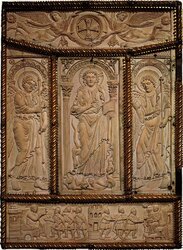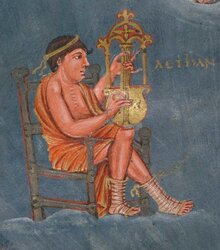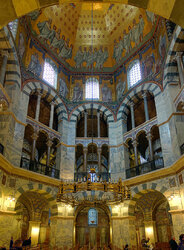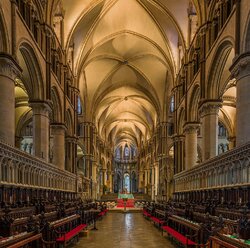Very little changed with the "fall" of the Western Roman Empire: a Roman Emperor was usurped by a Romanized German Emperor who swore fealty to the Byzantine/Eastern Roman Emperor. Zeno. The period of time from 476 AD until the mid 6th century was actually a time of growth and prosperity for much of Europe, especially the Byzantine Empire. It was in the mid 6th century however that the Plague of Justinian began, which was just as deadly if not deadlier than the Black Death; between 25 million and 100 million died. Massive depopulation occurred that only worsened due to frequent wars against the Persians in the east and the Ostrogothic kingdom in Italy. Northern Italy, for example, was so devastated that the invading Germanic Long Beard tribe/Langobards/Lombards just moved in with little conflict to found modern day Lombardy. Major building projects were put on hold or cancelled due to lack of funds and manpower, such as this church ruin in Greece:

It was around this time that baths were largely abandoned for a variety of reasons. Due to the massive loss of life, you had less engineers and architects to repair centuries old aqueducts and water systems. . Even Marcus Aurelius criticized the Roman baths three centuries earlier at Rome's height, calling them disgustingly filthy. You see, the health benefits of ancient Roman baths was way overstated. The water in the baths was rarely replaced and was full of sweat, dirt, and
worse. By the 5th century, Roman baths were more associated with prostitutes and street gangs than hygiene. This doesn't mean that people back then didn't bathe; it was instead done in private or by the river. The image of a dirty peasant having an inch of mud on his face 24/7 is a overcorrection of the Errol Flynn Merry Olde England fantasy. Even in Anglo-Saxon England, we have records of a priest telling his congregation to make sure to take baths on Saturday or he wouldn't let them in the church.

On top of all this chaos, Islam exploded out of Arabia and took advantage of the weakened Persians and Romans, resulting in the almost complete annihilation of Persia and the Zoroastrian faith and the conquering of nearly 2/3 of the Christian world by the 8th century. Europe would experience Islamic slaver raids and looting expeditions frequently for the next 400 years until the First Crusade (including that time Islamic armies sacked and desecrated the original St Peters Basilica in 846. Even so, you still had people like Isidore of Seville, who composed the
Etymologiae, an encyclopedia of ancient literature, in 6th-7th century Spain.
The rise of Charlemagne and his Karling descendants in the 8th century would result in a new age: the Carolingian Renaissance. An emphasis on documentation and literacy led to a massive increase in manuscripts and art.

Charlemagne himself conducted research on the efficacy of growing certain herbs and vegetables in church and private. The three field agricultural system was established over the ancient two field system.
Italic script and the question mark was invented at this time. A modernization and Teutonization of ancient Roman aesthetics was born; called Romanesque, which let northern Europe develop its culture separate from the Byzantine dominated south. Old Roman instruments were reinvented and brand new ones were created in order to write new styles of music.

Dozens of churches, cathedrals, palaces and other structures were built throughout Germany, Italy and France such as those below:


This time period would end with the increasing intensity of the Viking raids and the break up of the Carolingian Empire into France and the Holy Roman Empire, but yet another rebirth would happen soon after. The 12th century Renaissance, as it is known, began due to a combination of the European Warming period and the increased volume of trade between the Levant and Europe after the First Crusade. Climate change meant grapes could be grown in England to create wine and wheat could be grown in Iceland. A surplus of food led to a population boom. By this time, the average caloric intake was higher than that of the average Roman in ancient times. You have the birth of Gothic architecture and the university system where philosophy, theology, law, and ethics were openly debated amongst peers. New statues and funerary art would rival that of the Greco-Roman world

You had medieval scientist priests (yes, scientists) like Roger Bacon who researched optics and was the first European to compose the chemical composition of gunpowder. Saint Albert the Great who devoted his life to astronomy and natural law. Matthew Paris was a cartographer who created specialized maps from London to Rome which included illustrated depictions of famous landmarks for travelling pilgrims like a travel brochure. Saint Bonaventure, John Peckham, William of Ockham... You even had women like Hildegard of Bingen, a German nun who wrote medical treatises based on research done in the convent garden in addition to writing philosophy, psychology manuscripts and music. Her advice and council was sought after by religious authorities throughout the region.
The upright windmill was invented and proliferated throughout Europe. Military technology rapidly changed during this time and army recruitment moved from the old Germanic feudal system to a mercenary contract system. Fashion would change increasingly more frequent, especially women's fashion. Fabrics like cotton were first introduced. Armor and weapons would constantly evolve and adapt against once another to the point where major changes happened on a decade by decade basis.
This period of prosperity would end for a brief time due to the end of the Warming Period around 1300, a series of crop failures throughout Europe, the beginning of the Hundred Years War in 1337, and of course, the Black Death until the beginning of the Italian Renaissance.








